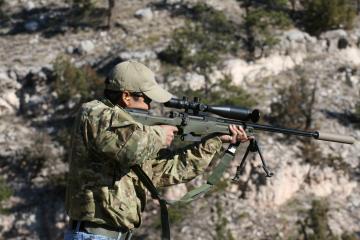Shotgun News, 1 OCT 2007

 This .300 Winchester Magnum rifle is long and heavy, but it doesn't buck the wind as well
as the more compact .260 Remington. This shooter is engaging two small targets at close-range
before transitioning to the long-range targets on a military course in Wyoming.
Imagine you're in the middle of a practical rifle match, hiking to the last of the five shooting
positions in the evolution. You have to locate, range, and engage another six targets in three
minutes and you've been carrying your .300 Winchester Magnum all day. The recoil isn't that bad,
but you find yourself having to concentrate on getting good trigger presses after the day's
exertions. Judging wind is the crux of making long-range hits, and wind changes have caused you a
few misses already today.
It's times like this when shooters wish for a lighter rifle, shooting ammunition that cuts through
the wind better, drops less, and has less recoil. Sometimes going bigger isn't the answer; a larger
magnum - like the .338 Lapua - might solve the ballistic problems, but at the expense of an even
heavier rifle with more recoil.
Tactical shooters can be a dogmatic bunch, with some good reason. They have trained on a
specific weapons system, shooting one kind of ammunition with one set of data, and they are
comfortable with it. This can make arguing for a new bullet or cartridge a hard sell when the
answer isn't 175-grain M118LR, the long-range accuracy loading of 7.62x51 NATO for sniper rifles.
To contrast, long-range competition shooters in disciplines such as F-class, High-Power, Palma, and
Benchrest have been experimenting with new bullets for ages, and have accumulated a lot of
experience with the long, sleek, high-BC 6.5 mm and 7 mm bullets.

 Left to right: .260 Remington, .308 Winchester, 6.5-08 Ackley Improved, .300 Winchester Magnum, .338
Lapua Magnum. The Ackley version has a higher muzzle velocity than the .260, but it requires
fire-forming brass and will give less barrel life.
In the last 15 years, long-range "practical" or "tactical" rifle matches have become popular, in
part promulgated by Dr. David Kahn's Keneyathlon ("hunters test") format. These matches include the
International Tactical Rifleman Championships (WY), Practical Rifle Team Challenge (CO), the NRA
Whittington Center's Sporting Rifle Match (NM), the Blue Steel Ranch Steel Safari (NM), and various
"Sniper Challenge" matches around the country. While conventional tactical calibers like .308 and
.300 Winchester Magnum were initially the choice of competitors, it didn't take long to figure out
that shooting sleeker bullets faster produced a dramatic improvement in making first-round
long-range hits.
The 6.5 mm bore size - the metric designation for .264 - has not been a big hit in the United
States, since our legendary rifle cartridges are .30-06 and .270 Winchester. However, in Europe the
6.5 mm caliber has a long history, in large part due to the 6.5 mm Swedish Mauser cartridge. The
6.5x55 mm Swede is as popular in Europe as .270 is here, and it is regularly used to take large game
including moose.
|